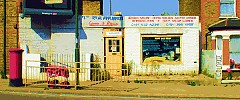|
The southernmost section of the A218, which runs from Wandsworth to Merton, west of the River Wandle. The Haydon family had
been living in Merton for over two hundred years when George Haydon acquired Cowdrey’s Farm in 1746. The site of the
farmhouse is now marked by Cowdrey Road. The track that led to the farm from Merton High Street had been called Cowdrey Lane,
but soon became known as Haydons Lane. In the 1840s Plough Lane branched eastwards off the northern end of Haydons Lane, in
the direction of the Plough Inn, which lay across the Wandle. The arrival of the railway in the 1850s brought early suburban
development as part of what was initially called New Wimbledon, later South Wimbledon. The Church of England established a
mission in a small room off Haydons Lane in 1859. Around 1870 the lane was renamed Haydons Road and streets of working class
housing began to be laid out, like De Burgh Road in the 1870s and Dryden Road in the 1890s. Just before the First World War
Wimbledon football club built itself a new ground on a former refuse dump at the corner of Plough Lane. The club decamped
to Crystal Palace in 1991, and then to Milton Keynes in 2003, leaving the old ground derelict. While the main drag of Haydons
Road now presents a messy appearance, much of the housing in its hinterland is pleasant enough, including some new properties
behind the station.

|

